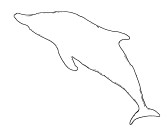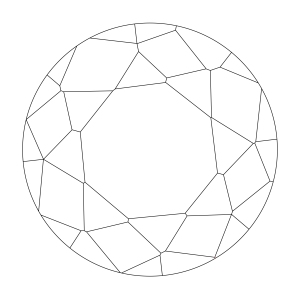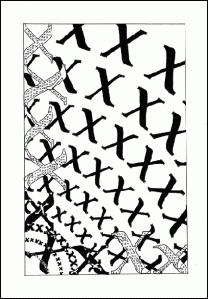While my prior two blogs discussed abstract concepts in Christian Leborg’s Visual Grammar, today’s blog discuses concrete concepts – concrete objects and structures.
Concrete objects have defined limits, contour lines, which define the objects’ shapes or forms. The shape, or form, may be clearly perceivable by the viewer, or the shape may be difficult to perceive if there are small differences in color in its contour line(s). These objects have perceptible form, size, and color. In visual grammar, there are three basic types of forms.
Geometric forms “are based on mathematical facts about points, lines, surfaces, and solids” (28). Organic forms are either created by or based on living organisms. Random forms can come into existence from several different processes. First, they may be the result of reproduction, such as an attempt by an artist to reproduce events that took place elsewhere. Second, they may result from unconscious human actions. Finally, they may be an incidental influence from nature, such as the wavy lines made in water by the pull of the tides. Interestingly, the same shape may be present in two categories. The circle, for example, is both a geometric form and an organic form. The form of a wave, on the other hand, may be geometric, organic, or random, but will be different in each category.
The size of a concrete object is determined by the perspective of the viewer, the object’s relationship to other objects surrounding it, and “the format in which it will function” (30). For example, a building diagram for a piece of knockdown furniture may seem large if it is printed on a piece of 8.5 inch by 11 inch letter paper. In contrast, the drawing, at the same time size, will seem small if it is printed on a piece of paper ten times letter size.
The third perceptible characteristic of concrete objects is color, which comes from different wavelengths of light in the visible light spectrum. Because concrete objects and their materials absorb some wavelengths and reflect others, they appear to have color – the wavelengths they reflect. The measure of the wavelengths is the hue. Black is the absence of light because all of the wavelengths are absorbed, so it has no hue, yet it is also perceptible in concrete objects. White, the combination of all of the wavelengths, and therefore without hue, is perceptible in concrete objects as well. Although most people refer to colors by the name of their hues, colors are influenced by other characteristics such as saturation (intensity) and value (lightness or darkness).
Concrete structures have lines that are either visible or that actively influence the form of the objects in the structure. Visible structure lines can be a composition without any objects, They also give texture to compositions. A good example of invisible structure lines that actively influence the form of the objects is a composition in which objects get proportionately larger as they radiate out along invisible arcs from a central point.
In his blog about visual grammar on vanseodesign.com, Steven Bradley makes interesting comments about concrete objects. Like Leborg, he makes the point that we perceive concrete objects within defined contour lines. Further, everything inside of, and including, the contour line compose the concrete object under discussion. Anything outside of the contour line is a different element. Unlike abstract objects, concrete objects are elements that we can actually create and place on a page. In fact, every object we place on a page is a concrete object. “Abstract objects,” writes Bradley, only “exist to talk about objects in general in order to better describe them.” (http://www.vanseodesign.com/web-design/visual-grammar/)
An important distinction between abstract and concrete objects is that concrete objects possess the elements of design. On his website, John Lovett, a Sydney, Australia artist and author of books and DVDs on art, includes size as an element of design and defines it as “the relationship between the area occupied by one shape to that of the area occupied by another.” He also notes that a viewer perceives an object’s size in relationship to the other objects surrounding it. In addition, for the viewer to perceive a large object in a composition, the composition must also contain a small object. The comparison will make the larger object the dominant form. Further, Lovett states, when the difference in object sizes is comfortable, there is little tension in the composition. Large differences is size create tension, and, therefore, add impact. Romantic landscape painters of the early nineteenth century often exaggerated differences in size to make the focal object appear monumental. (http://johnlovett.com/design/?page_id=50)
Texture is also an element of design, and unlike abstract structures, concrete structures are often visible and can give visual texture to a two-dimensional composition. Lovett defines texture as “the illusion of physical texture”, created with either materials or through the design principle of repetition. (http://johnlovett.com/design/?page_id=978) When discussing Paul Klee’s painting, Heroic Strokes of the Bow in his section on repetition, Lovett notes a series of repeating arcs and lines that cross each other on their way down the painting. A series of dots, squares, circles and dashes weave their way through the arcs and lines. These two series give both structure and pattern to the painting.
http://mhsart1.wikispaces.com/Shape
This drawing’s contour line defines its shape. We are able to recognize that this is a dolphin even though the only information given to us is the contour line.
http://www.pierre-a-facettes.ch/CutQuality.html
This line drawing of a gem is very geometric as the surfaces created by the lines are based on mathematical facts, thus making the drawing into a theoretical solid.
http://nextgenlite.com/tag/visible-light-spectrum/
This graph shows which colors in the visible light spectrum have the longest wavelengths, or the hues which are most visible when reflected off an object.
http://tgj4m-blkd.wikispaces.com/Elements+of+Design+-+Size+%26+Proportion
Most viewers know that Legos are actually small, but the larger Lego figure in this composition seems monumental because of the exaggerated smallness of the figure placed on its shoulder.
http://robert-maynard.net/html/traditionalpaint.html
The arcs in this composition are visible only as negative space, yet they control the shape of the object forms. The forms get larger as the structure lines (arcs) radiate out further from the center.





